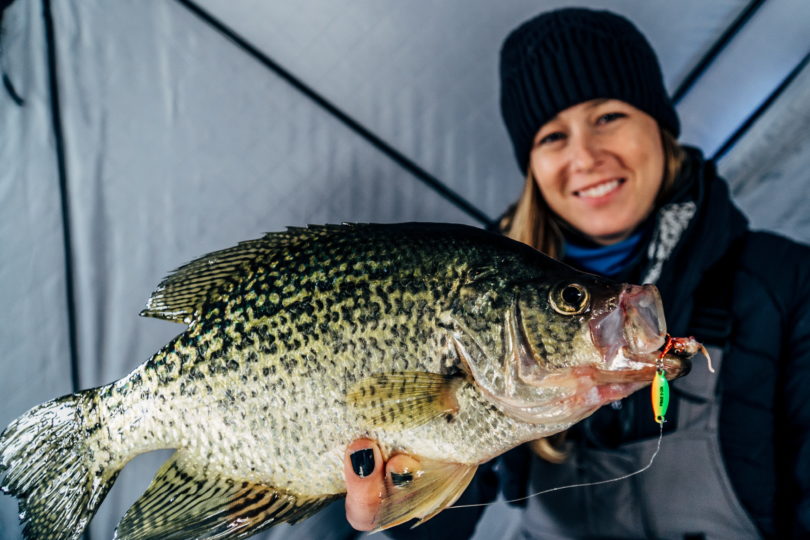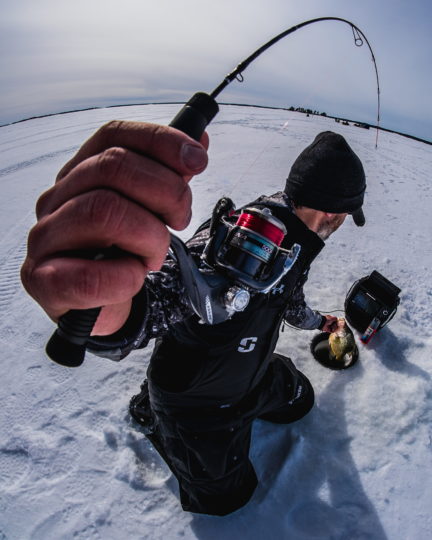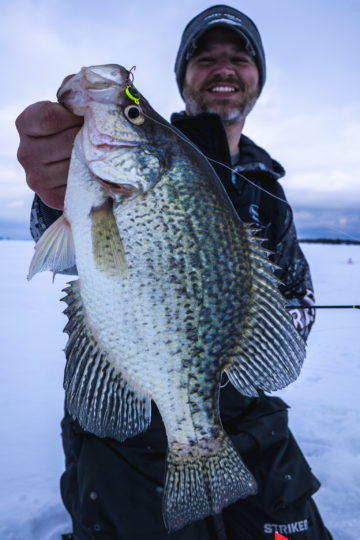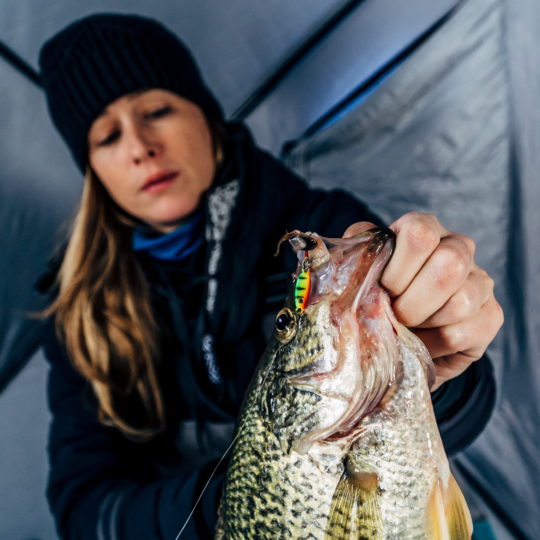
What’s it like taking a girl to an island in the middle of Lake of the Woods in March?!
Spoiler: That woman is me, Sara Trampe, host of Sportsman’s Journal, so we are catching BIG fish!
We spent 4 nights at Tamarack Island Wilderness Lodge – 8 miles out of Morson, Ontario – in the middle of March last year. There is no running water – and all that goes with it, showers, toilets, etc. – there are no ice roads, there is no internet and low cell signals … But the fishing is just as unbelievably good as in the summer, and I mean it was INCREDIBLE! We were planning on fishing action-oriented walleyes and maybe some northern, but we found something different – trophy crappies, by the bucketful.
Our host, and owner, Todd Hacault, and his son Paul usually spend a few days on the island every winter hitting the ice, checking their property, and bringing out supplies. After many years of being invited, we were finally smart enough to take them up on their offer and join them for a few days of fishing. Our only regret is not going sooner.
The night before our trip we drove North to the Minnesota / Ontario border and stayed in a hotel on the U.S. side. We did this for me to be able to shower and wash my hair as close to our trip as possible – knowing I would go days without while filming for Sportsman’s Journal. I may be a little more “high maintenance” than the guys in that aspect, but Tyler giving me that extra time it makes for a happier team.

We crossed the lake using snowmobiles, which meant little space for gear. Being organized is a huge help for these types of trips. We travel with around 70 pounds of camera equipment alone, so there isn’t a whole lot of extra space going out to the island. Therefore, I packed 2 bags; one for the hotel room with my shower stuff and one for fishing.
The next morning, I was up at 4 A.M., got ready, and we were on our way. After crossing the border, we drove the remaining 45 minutes to the launch to meet Todd and Paul. We shared hugs, started unpacking the truck and packing the sleds, and bundled up in our Striker suits. Todd jokes we even had room for the hairdryer, but I left that in the truck!! After we finished securing our gear, we put our helmets on and headed off on a 20-minute jaunt over Lake of the Woods. We dropped some stuff in the cabin and out fishing we went.
When you are on Lake of the Woods the possibilities, spots, and fish are endless. Remember, we planned on fishing walleyes which are abundant in the Tamarack area, so we weren’t too concerned with where to start. We went about a 1/2 mile from the island and started unloading when Todd casually mentioned his buddies were out last weekend and caught a couple of crappies. If you have ever watched our show you know Tyler LOVES crappies, so he was locked on to a different mission – finding those crappies!

We started dissecting the structure of the lake and estimating the location of the deepest basin in the area. Let’s talk about Lake of the Woods for a second. When you talk about breaking down a lake, Lake of the Woods (LOTW) is a beast. LOTW borders Minnesota, Ontario, and Manitoba Canada, and is just shy of 1,000,000 acres with no shortage of habitat and structure. There are over 1,600 miles of surface area, 65,000 miles of shoreline, and over 14,000 islands. LOTW is a world-class fishery with varying degrees of water clarity, depths, and numerous species in different areas of the lake; so much so that different geographical areas are almost like different lakes. The Tamarack Island area is fish dense with stained water, islands, mid-lake underwater reefs, basins, and rich in nutrients … which means the fish are thick.
We used our lake maps and plotted out the best place to start drilling holes … well, Paul and I drilled holes while Tyler and Todd filmed an intro. Paul has a Jiffy gas-powered auger that came in handy with the 30+ inches of ice! But my go-to is the ION electric auger; it’s lightweight and easy to use (as long as you remember to charge the batteries!). We did not drill a thousand holes for 2 reasons: 1.) it’s NW Ontario, cold and windy and holes freeze quickly and 2.) it’s LOTW so we didn’t need many before we were marking fish.
A prominent characteristic of crappies is them being suspended in the water column while roaming flats in deepwater basins searching for food sources. When we marked fish high versus marking fish hugged up to the bottom, we knew where to pop up the hub tent.
The hub was up, but before we were fully set up we were fishing, knowing crappies were waiting for us. Fish are marking on the screen suspended 5-10 ft off the bottom, and Tyler is rigged up and ready to go using a Northland Fishing Tackle Eye-Ball Spoon and Macho Minnow. Jig. Jig. BOOM! Tyler eased up the fish through the ice and we both couldn’t believe our eyes … a large gaping papermouth was our first glimpse and realized it was a whopper! The first crappie up was 14 inches. Okay! We know the crappies are here! Back out we go to drill holes 20 – 40 yards surrounding the shack for our Finicky Foolers.
If you haven’t tried a Finicky Fooler yet and you enjoy ice fishing, I highly recommend having at least 1 in your arsenal. These bad boys are similar to the tip-down you would use for panfish, yet you use a rod and reel set-up with an open bail. When the flag flies you run, flip the bail, set the hook, catch the fish. These can be used to replace tip-downs or tip-ups, a very versatile tool and easy to use. We rigged ours up with a Northland Fishing Tackle eyeball spoon tipped with a dorsal-fin hooked live fathead, which turned out to be an irresistible presentation.
While Tyler was finishing the Fooler set-ups (in Ontario we are allowed 2 lines per angler on the ice) I managed to find myself back in the tent jigging with a 1/16 oz perch color Forage Minnow Spoon tipped with a minnow head. Ok. I confess I snuck back into fish.
There are fish all over my screen. As I drop my spoon down a fish chases up to inspect, I snap the bail and entice the fish to follow me up, a little further, a little further, and BAM! Fish on. We aren’t fishing very deep but the fish are not shooting up through the water column, so I know there is some weight to this fish. Once it’s up into the hole we realize it’s another GIANT crappie! Our first two crappies are true slabs! Prior to this trip, we were completely unaware that big crappies were this close to camp.
Flags were flying, walleyes and crappies were being caught all day, and we were going through minnows like crazy. But the bite slowed around dusk (4:30 – 5:00 pm) due to water clarity the sunlight penetration faded and it was harder to see our baits. We packed up for the evening and arrived back at our fully powered, toasty warm cabin to the delicious smells of our steak dinner with hand-cut fries. After eating we visited for a bit and then off to bed we went, with dreams of more slab crappies swimming in our heads.

Day 2: We landed back in our spot on the morning of day 2, re-drilled necessary holes, and were right back pulling crappies through the ice. The old saying “never leave fish to find fish” applied here! We knew the crappies were using the mudflats and were hitting our baits, so why move?
We were marking fish as soon as our electronics were on, and after playing the fish up and down for about a minute I felt a sharp tug and a lot of drag pulling from my reel. If this was a crappie it was a true slab!
I always get nervous with the thick ice because I like to see the bottom of my hole in order to guide the fish in without getting stuck on the ice. It’s important to remember to keep your line tight and guide the fish into the hole, if you reel too aggressively you may end up getting the fish stuck on the bottom of the ice where the hook can easily pop out. After guiding the head through and up the hole and seeing my hook secure in the fish’s mouth I realize that it’s a large cisco! Not what I was expecting but still a fun fight. Ciscoes are a high-protein forage base and a very popular item on the musky menu. This explains why the muskies surrounding Tamarack are all fat and so much fun to catch … but that’s a different article.
I re-rigged my Forage Minnow Spoon with a minnow head and dropped back down. We marked fish off and on throughout the morning and typically when a fish followed up and down chasing baits for a minute or longer it was a cisco. While the big crappies were not underneath us continually, they consistently swam through searching for food. So, when I hooked up with a fish that had chased my spoon for a bit I assumed it was another cisco; as it pulled drag and bull-dogged I was relaxed and had fun with it. But when the fish came up the hole and I comprehended that it was a whopper calico I became laser-focused. That crappie hit the top of the hole and out popped my spoon; the fish is lying unhooked in the hole while Tyler made a mad leap and grabbed it before it was able to turn around and swim away. This slab was a 15-inch true trophy – a mounter for sure!
Tyler and I significantly practice catch and release. We are conservationists and want to protect these resources to be able to share these experiences with our daughter and grandchildren. When we plan on releasing fish we fight them carefully and methodically, because the fish need to acclimate on the way up and not be exhausted to a point of no return. We only keep the fish out of the water for minimal time frames and dip if necessary, to keep the fish fresh. These fish then need to swim back down the 30+ inches of ice column before being able to re-climate and safely return to the bottom. A dead fish under the ice isn’t a true release. While crappies are prolific spawners, trophy fish are a treasure to be shared and proper handling is required.
Our final day was beautiful and we continued to catch crappies, eater walleyes, and cisco the entire trip. It was truly unforgettable and may even be considered a fish tale, except it, was all caught on camera and will be airing on January 9th, 2021 on Fox Sports.
We enjoyed a delicious fish fry the last night of our trip despite the news that the U.S.-Canada border would close and we all needed to return home quickly. The U.S.-Canada border has only closed once before, immediately following the 9/11 attacks, for a brief time frame.
Due to the COVID situation, the U.S.-Canada border remains closed, but as soon as it opens we will be reserving our spot once again. Tamarack Island Wilderness Lodge plans on accepting reservations for ice fishing as soon as the border opens for limited groups and it is a must on any fisherman’s bucket list. An ice fishing trip, in the middle of LOTW, in March, in a toasty warm cabin, real bed, great company, and catching trophy crappies. That’s a trip to remember, and return to!

